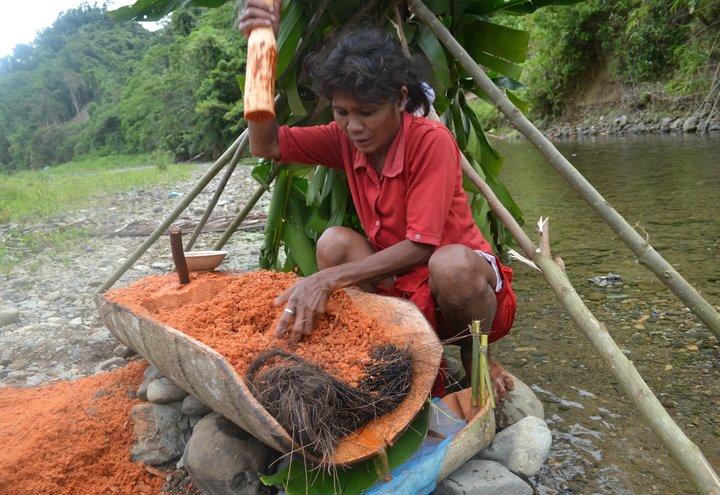The sacredness of the Pugahan tree - an interview with one of the photo contest winners

Leonora Astete tells a story of agricultural rituals, describing in detail a very rare Filipino practice to produce flour from a tree’s sap.
One of our photo contest winners Leonora Astete (pictured below) tells a story of agricultural rituals, describing in detail a very rare Filipino practice to produce flour from a tree’s sap. We enjoyed her tale and her respect for the Dumagat tribe traditions since she is passionate about conserving their habitat, life style and values: elements strongly connected among themselves.
Leonora and the other two winners of the photo contest (interviews with them will be posted later this week) will each receive a digital photo camera.
Tell us about yourself. Are you a farmer, a research fellow, a traveler? What do you do in your life?
I am a Community Program Officer working with the Lyceum of the Philippine's University's Community Outreach and Service Learning unit. As of four years, our program has been focusing on indigenous people living in the Sierra Madre Mountains. These people are securing what is left of their forests and land from disrespectful people.
I am also a teacher of literature and a faculty researcher; hence, my engagement with Aranta, the woman in the photo (on the left) and her community. This work includes the study of their indigenous knowledge systems, practices and beliefs. All of these are present in their stories, poems and songs. I find their cultural values worth sharing with my students.
Why is agricultural biodiversity important to you?
Since land is an anchor for all agriculture forms and a major part of the indigenous peoples' lives anything that pertains to it has implications to their well-being and continuity as a community. Thus, agricultural biodiversity must be preserved and sustained as it is part of the lives of these people.
Tell us more about the local Pugahan tree. In which areas of the Philippines can you find it? Is it a well-known tree?
The Pugahan tree, also known as the fishtailed palm, grows naturally in certain areas in the Sierra Madre Mountain Range in the northern Philippines. Indigenous people consider this tree as their survival food and they also believe in its sacredness.
Spirituality among these people is anchored in the land, the soil from which life comes from. It is for this reason that the slogan “land is life,” has been put across many times over as the protest theme against human incursions such as irresponsible logging. Aranta treats the Pugahan tree as a human being as she constantly asks it to be patient with her ritualistic activities in obtaining the flour.
 In the photo, Aranta shows only the last stage of the process, when the flour is being processed from the trunk of the Pugahan tree. How does the whole process work?
In the photo, Aranta shows only the last stage of the process, when the flour is being processed from the trunk of the Pugahan tree. How does the whole process work?
The ritual to get the "yuro" flour is very complex and takes a whole day. Only women are given the privilege to do it; men can just assist in the felling and the moving of the tree. All tools involved come from the tree itself and from other surrounding plants, except for the tool used to cut down the tree.
Pugahan is cut into one meter long parts, by inserting three wooden wedges which also come from the Tamauyan tree. The inner part, or pith, is taken by using a hook shaped created from the wood of the tree; it is collected and pounded, occasionally sprinkled with water.
In the past only one woman was allowed to do the mashing and nobody could have replaced her or the sap would dry out. Finally the sap settles at the bottom of the alabet tree’s bark and becomes flour, ready to be poured into a rough cloth and hung for air-drying. At the end, Aranta says to the disintegrated tree: “I'll come back with many others so do not worry, many will partake of your body”. The next day the whole community feasts on it.
What are the nutritional properties of this food?
It is considered scientifically at par with the nutrients of the sweet potato and other root crops. It has higher fiber value than rice. Through repeated washing and straining the alkaloid contents are removed. It is rich in carbohydrates and calcium. We were told that the flour from one tree could feed a community of about 10-15 families for a week.
Do people use it for purposes other than nutrition (e.g. medicinal and ritual uses, as fodder, etc.)?
When the tree is felled, nothing is wasted. Leaves are used for roofing; midrib of leaves for stick brooms; the stem for housing.
How it is usually consumed?
There are different ways. It can be roasted on fire, without adding salt, oil or sugar, since these people believe that the rest of the flour could stale if they use other ingredients at the first cooking step. Later, they can put sugar and fry it like pancakes. Binungu is one of the favorite dishes of Dumagat people: a thin layer of yuro on the tagbak leaf, rolled with a slice of wild boar meat, then roasted on fire.
Why does Aranta and the other few Dumagat people continue to observe this practice instead of using a mechanical tool?
Both Aranta and the tree are nurturers. They embody the definition of 'Mother Earth'. Hence, the indigenous peoples’ resilience depends on their cultural continuity strengthened by their spirituality, their conception of kinship structure and their attitude in considering their natural habitat with respect and sacredness.
~~~
Learn more about the winners of the 'Women and Agricultural Biodiversity' photo contest and see all 195 images on Facebook.
